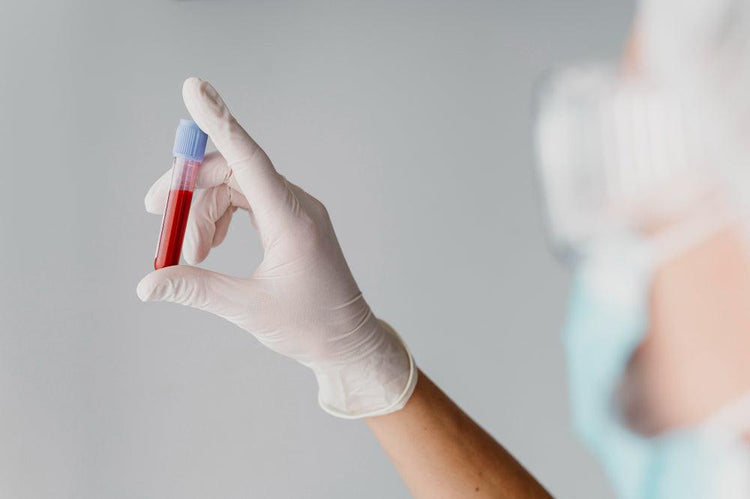What is a normal blood test range?


Related products
Blood tests are one of the most reliable, cost-effective, and accessible tools in modern healthcare. They offer critical insights into how your body functions at a cellular level, often revealing underlying issues long before symptoms show up. But for many people, reading blood test results can feel like trying to decode a foreign language.
What exactly does a "normal" range mean? And what happens when your values are just outside those parameters? Understanding these numbers—and what they say about your health—empowers you to take control and make proactive choices.
In this article, we’ll walk you through what constitutes a normal range for key components in your blood, what to do if something looks off, and how lifestyle, diet, and targeted testing can help you get back on track.
How to Prepare for a Blood Test
Not all blood tests require the same level of preparation. In many cases, you can eat and drink normally before your appointment. But for certain tests—like fasting glucose or cholesterol assessments—your doctor might ask you to avoid food for 8–12 hours beforehand.

Before your blood test, consider the following:
-
Fasting? Confirm if your test requires it.
-
Stay hydrated: Water improves blood flow and makes the draw easier.
-
Avoid alcohol and caffeine: Especially within 24 hours before the test.
-
Note your medications: Some can alter your results—inform your doctor.
Preparation ensures your results are accurate and reflective of your baseline health, especially for tests measuring hormones or metabolic markers. For instance, if you're tracking stress levels through a Cortisol Blood Test, timing and preparation play a big role in the accuracy of your results.
What to Expect During and After a Blood Test

Most blood tests are quick and relatively painless. A nurse or technician will insert a needle into a vein in your arm, usually near the elbow, to collect the sample. The whole process takes about five minutes.
After the blood draw:
-
You can resume normal activities immediately.
-
Mild bruising or soreness may occur but typically fades within a day.
-
Results may take anywhere from 24 hours to a week, depending on the test.
Once the lab processes your sample, your doctor will interpret the data within the context of your health history and symptoms. If you're using a home kit from platforms like the Welzo Blood Test Hub, your results are often delivered digitally, along with an explanation of what the values mean and whether they fall within normal limits.
Red Blood Cells (RBCs): What’s Normal and Why It Matters
Red blood cells are critical for transporting oxygen from your lungs to every cell in your body. They also help remove carbon dioxide by carrying it back to the lungs for exhalation.
Normal Ranges:
-
Men: 4.3 – 5.9 million cells/mcL
-
Women: 3.5 – 5.5 million cells/mcL
A lower than normal RBC count may indicate anaemia, blood loss, or nutrient deficiencies. Higher levels can result from dehydration, smoking, or conditions like polycythaemia.
To support healthy RBC levels:
-
Eat iron-rich foods like red meat, lentils, spinach, and tofu.
-
Include vitamin B12 sources such as eggs, dairy, and fortified cereals.
-
Consider a Ferritin Blood Test if iron deficiency is suspected.
Balanced RBC levels ensure adequate oxygen delivery, supporting energy, cognitive function, and exercise performance.
White Blood Cells (WBCs): Your Immune System’s First Responders
White blood cells are vital to immune defense. They attack viruses, bacteria, and other invaders, and their numbers rise when your body is under threat.
Normal Range:
-
Adults: 4,500 – 11,000 cells/mcL
Too few WBCs can result in frequent infections and poor healing, while too many may suggest infection, inflammation, or blood disorders.
Support WBC levels with:
-
A diet rich in vitamin C (citrus, bell peppers), zinc (pumpkin seeds), and probiotics (yogurt).
-
Limiting processed sugar, which suppresses immune response.
If you're experiencing ongoing fatigue and low immunity, a CRP Blood Test can help detect underlying inflammation that could be affecting your white cell count.
Platelets: The Body’s Clotting Agents
Platelets prevent excessive bleeding by clumping at injury sites. They’re essential for healing and circulatory integrity.
Normal Range:
-
150,000 – 400,000 per microlitre of blood
Too few platelets can lead to bruising and slow clotting, while too many may raise the risk of dangerous clots or strokes.
To balance platelet levels:
-
Increase vitamin B12 and folate through foods like leafy greens, legumes, and shellfish.
-
For high counts, focus on anti-inflammatory foods like garlic, ginger, and tomatoes.
Those with unexplained bruising or excessive bleeding might benefit from a comprehensive Full Blood Count, which includes platelet analysis.
Haemoglobin: Your Blood’s Oxygen Carrier
Haemoglobin is the protein in red blood cells that binds to oxygen. It’s directly responsible for how efficiently oxygen is delivered to your tissues.
Normal Range:
-
Men: 13.5 – 17.5 g/dL
-
Women: 12.0 – 16.0 g/dL
Low levels are often linked to anaemia, fatigue, and dizziness. High levels can result from smoking, lung disease, or dehydration.
To maintain healthy levels:
-
Eat more iron-rich foods.
-
Supplement with B vitamins as advised.
-
Reduce sugar and alcohol to improve absorption.
Women experiencing menstrual irregularities and low energy may also consider a Female Hormone Blood Test to rule out hormonal causes contributing to low haemoglobin levels.
Thyroid Function: A Silent Influencer of Blood Health
Your thyroid gland regulates metabolism, energy, and temperature. Imbalances can indirectly affect red and white cell production, fatigue, and even mood.
Common symptoms of dysfunction include:
-
Cold sensitivity
-
Weight changes
-
Brain fog
-
Hair thinning
A normal TSH range is typically 0.4 to 4.0 mIU/L, but this may vary by lab. A Thyroid Function Blood Test can help identify underactive or overactive thyroid issues that may be affecting your overall blood profile.
Sex Hormones and Blood Cell Production
Hormonal health isn’t just about reproduction—it also influences your blood. For example, testosterone helps stimulate red blood cell production, and its deficiency can lead to anaemia in both men and women.
If you're dealing with chronic fatigue, low libido, or reduced muscle mass, it may be wise to check your testosterone levels. The Free Testosterone Blood Test offers a snapshot of your hormonal influence on red blood cell production and overall health.
Hormonal imbalances can also affect clotting, immune responses, and how your body reacts to stress, making them a key piece of the diagnostic puzzle.
Normal Ranges: Quick Reference Table
Here’s a simplified snapshot of common normal blood test ranges:
| Test | Normal Range |
|---|---|
| RBC (Men) | 4.3 – 5.9 million/mcL |
| RBC (Women) | 3.5 – 5.5 million/mcL |
| WBC | 4,500 – 11,000/mcL |
| Platelets | 150,000 – 400,000/mcL |
| Haemoglobin (Men) | 13.5 – 17.5 g/dL |
| Haemoglobin (Women) | 12.0 – 16.0 g/dL |
| TSH | 0.4 – 4.0 mIU/L |
| Cholesterol (Total) | Under 200 mg/dL |
Remember that “normal” may vary slightly depending on the lab and individual factors like age and gender. Sometimes it’s not just about a single test, but understanding the full picture. That’s where curated test collections come in. For instance, if you're interested in metabolic, liver, and cardiovascular health, the All Health Tests Collection offers a convenient way to assess multiple markers in one go.
For those focused on performance and energy, especially athletes or those managing intense training regimens, the Sports Performance Tests Collection covers vital elements such as cortisol, iron, and testosterone.
These grouped test panels help you take a more holistic approach to your health.
Conclusion: Taking the Guesswork Out of Blood Test Results
Understanding what’s normal in a blood test isn’t just a numbers game—it’s a reflection of your body’s internal dialogue. Knowing your baseline, recognising warning signs, and making the right lifestyle changes can significantly impact your quality of life.
From red blood cell counts to hormone panels, today’s blood tests offer an unprecedented view into your health—and services like Welzo’s Home Blood Tests make it easier than ever to take action from the comfort of your home.
Whether you're proactively tracking your well-being or managing an existing condition, consistent testing and education can empower you to make better choices, earlier—and that’s the real power of understanding your blood.






























 Rated Excellent by 26,523+ Reviews
Rated Excellent by 26,523+ Reviews